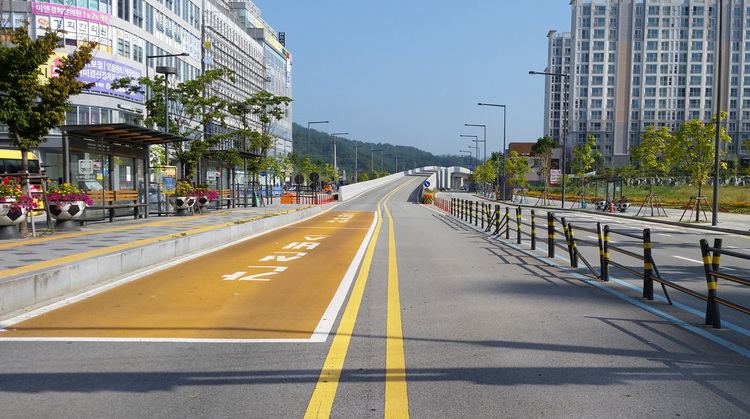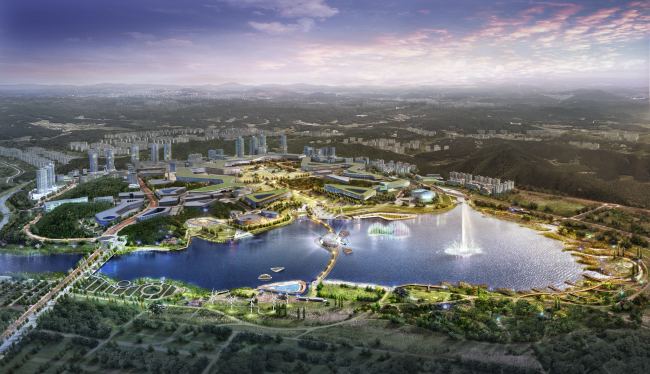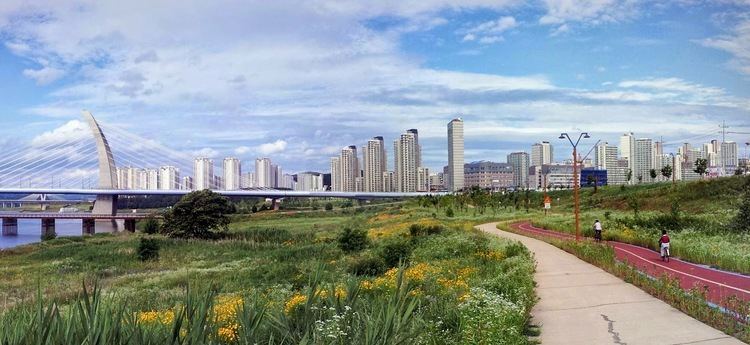NeighbourhoodTownTownships 219 Area 465.2 km² Bird Oriental dollarbird | Website sejong.go.kr Population 230,327 (May 2016) | |
 | ||
Weather 4°C, Wind SW at 8 km/h, 85% Humidity University Korea College of Media Arts | ||
Sejong ([se(ː).dʑoŋ]; Hangul: 세종; Hanja: 世宗), officially Sejong Special Self-Governing City (Hangul: 세종특별자치시; Hanja: 世宗特別自治市) and formerly known as Yeongi (연기, 燕岐) County is South Korea's de facto administrative capital city. In early 2007, the South Korean government created a special administrative district from parts of South Chungcheong Province and North Chungcheong Province provinces, near Daejeon, to relocate nine ministries and four national agencies from Seoul. The new capital opened on 2 July 2012, with 36 government agencies slated to move there by 2015.
Contents
- Sejong city
- Name
- History
- Geography
- Cityscape
- Administrative divisions
- Population and demographics
- Government and infrastructure
- Educational facilities
- Air
- National railway
- In popular culture
- References

Sejong city
Name

Sejong was named in honor of the Joseon Dynasty King Sejong the Great, the father of Korea's national alphabet.
The city was originally called Yeongi County (연기, 燕岐).
History

In 2003, former President Roh Moo-hyun of the Democratic Party (now Minjoo Party of Korea) sought to relocate the national capital of South Korea from the metropolitan city of Seoul to a new multifunctional administrative city in the centre of the country. The goal was to reduce the influence and dominance of Seoul on national governance and economics, whilst promoting the regional development of other areas of the country. According to former Home Administration Minister Maeng Hyung-gyu in 2012, “Sejong is a symbol of the country’s efforts toward more balanced regional development", helping to decongest Seoul and spur investment in the country’s central region.

In October 2004, the Constitutional Court dealt a setback to President Roh's plans, ruling that the capital must remain in Seoul in response to a complaint filed by the main opposition Grand National Party (now Saenuri Party). As such, the Roh administration was forced to modify the project to relocate the majority of ministries and government institutes to Sejong, which would become a special administrative city instead of a new capital. The revised plan was approved by the parliament in March 2005. Challenges to the new plan were rejected by the Constitutional Court in November 2005.

When the Conservative Grand National Party retook the presidential office in 2008, President Lee Myung-bak opposed the idea of moving government agencies, claiming that it would hurt the capital’s global competitiveness and result in inefficiency. Plans were made to make Sejong an industrial, science and education hub instead. This plan was opposed by many, including Roh’s allies and some members of the ruling Grand National Party, including Lee’s archrival and eventual successor Park Geun-hye. Defeat in the mid-2010 local elections forced Lee to present the proposal to the National Assembly, which voted them down.

As of 2014, 36 central government offices, including nine ministries, and 16 state-run organisations have moved into the city. However, the national assembly and many important government bodies are still in Seoul.
In July 2012 Sejong was created incorporating all of Yeongi County, three townships of Gongju and one township of Cheongwon County.
In April 2013 the government of Putrajaya, Malaysia signed a letter of intent (LOI) with the government of Sejong City to mark cooperation between the two cities.
Geography
Sejong is located between three other major Korean cities: Daejeon, Cheonan and Cheongju.
It is about 121 kilometres (75 mi) from Seoul.
Cityscape
As of 2012 much of the city was under construction. The residential area, by 2012, had several high-rises built for transferees. At that time the residential area was cordoned off from much of the under-development governmental area and had some restaurants, six schools, and one grocery store.
Administrative divisions
Hansol-dong and Jochiwon-eup is the city main urban center. Sejong is divided into 4 haengjeong-dong (administrative neighbourhood), 1 eup (town) and 9 myeon (townships).
Population and demographics
The city aims to have a population of 200,000 at the end of 2012, 300,000 by 2020 and 500,000 by 2030.
Government and infrastructure
The South Korean government plans to move 36 government ministries and agencies to Sejong City.
The Sejong Government Complex is located in Sejong City. The complex, on a 213,000-square-metre (2,290,000 sq ft) plot of land, has seven stories and one basement. Construction began in November 2011 in what was South Chungcheong Province, and the complex was completed on November 16, 2013. The ceremony to mark the movement of several government agencies to the complex occurred on December 23, 2013.
The Sejong Government Complex includes the head offices of the Ministry of Land, Infrastructure and Transport (MOLIT), the Ministry of Trade, Industry and Energy (MOTIE), the Ministry of Environment, the Ministry of Oceans and Fisheries, the Ministry of Culture, Sports and Tourism (MCST), the Ministry of Education, the Ministry of Strategy and Finance, the Ministry of Agriculture, Food and Rural Affairs (MAFRA), and the Ministry of Employment and Labor (MOEL).
Several MOLIT agencies, the Korea Office of Civil Aviation (KOCA), the Korean Maritime Safety Tribunal (KMST), and the Aviation and Railway Accident Investigation Board (ARAIB), have their headquarters in the Sejong Government Complex.
The Ministry of Health and Welfare is also located in Sejong City.
Educational facilities
Universities
Senior high schools
Air
Sejong is also served by Cheongju International Airport in Cheongju, the nearest airport to Sejong.
National railway
Sejong is centrally located on Gyeongbu Line operated by Korail. It's a 90 minute journey on the Mugunghwa-ho to Seoul and trains run approximately every 30 minutes. Also just outside Jochiwon-eup limits in Osong, Cheongwon has a new KTX station Osong Station which is a KTX bullet train that frequently travels 300 km/h.
In popular culture
The 2015 tvN television series Let's Eat 2 is based in Sejong city.
